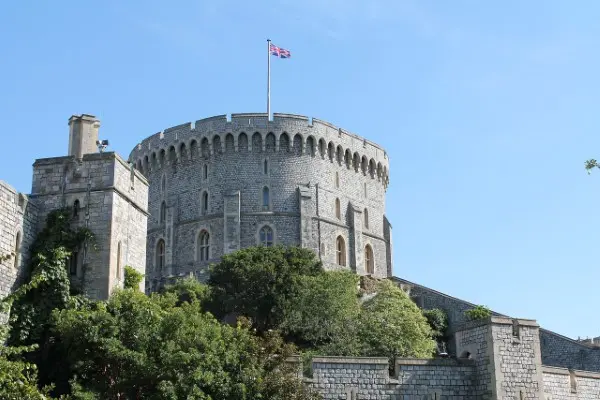Princess Alexandra - 1863
Prince Albert, the future King Edward VII, married Princess Alexandra of Denmark in St George’s chapel on the 10th March 1863.
Queen Victoria’s eldest son, affectionately known as ‘Bertie’ met with his arranged, 16-year-old future bride in the Cathedral at Speyer, Germany in 1861, which led to a proposal the year after. The Queen, still in mourning for her beloved Albert, watched the marriage ceremony in 1863, from the Catherine of Aragon closet.
Following the marriage at Windsor, Alexandra Caroline Marie Charlotte Louise Julia became Queen consort of the United Kingdom and the British Dominions, Princess of Wales from 1863 to 1901, and Empress consort of India.
Alexandra was quite popular and was considered fashionable by many women at that time.
Princess Helena - 1865
Her Royal Highness the Princess Helena Augusta Victoria was Queen Victoria’s fifth child and third daughter. Her birth was a difficult one requiring the monarch to rest and recover. Her father remarked she, "came into this world quite blue, but she is quite well now."
She grew to be a lively outspoken child and, in the time leading up to making a match to benefit the Royal Family, she enjoyed a flirtation with a palace librarian which caused considerable controversy. Queen Victoria despatched the offending member of staff back to his homeland Germany and the hunt for a suitable husband began.
As a fifth child, a powerful European match was off the table. Also, her appearance was said by her biographer, to be dowdy, chunky and double-chinned. To compound matters, the Queen required her daughter to live nearby to keep her close.
The choice of Prince Christian of Schleswig-Holstein was politically difficult due to the territories fought over by Prussia and Denmark. The marriage caused a rift in the family with Princess Alexandra who never accepted Christian, despite the fact they were third cousins.
Engaged on the 5th December 1865, they were married on the 5th July 1866, in the Private Chapel at Windsor Castle. Queen Victoria wore a white mourning cap and a black mourning dress to give away her daughter.
Queen Victoria never forgave Alexandra for her treatment of Christian, later writing, "Bertie is most affectionate and kind but Alix is by no means what she ought to be. It will be long, if ever, before she regains my confidence."
Princess Louise, Duchess of Argyll - 1871
Louisa Caroline Alberta was the sixth child and fourth daughter of Queen Victoria. She was a bright and artistically talented child and her inquisitive nature earned her the nickname ‘Little Miss Why’.
Louise, like her sister before her, developed affection for a member of staff. Queen Victoria removed the Tutor who later became Canon at Westminster Abbey and the search for a husband was on.
Being a pretty Princess and acting as the Queen’s unofficial secretary, the choice was wide as Louise was considered Victoria’s most beautiful daughter. However, the press hinted at romantic encounters and she was a staunch supporter of the feminist movement. The Queen again insisted that Louise live close by.
The headstrong Louise announced she did not want to marry a Royal Prince and stated her desire to marry John George Edward Henry Douglas Sutherland Campbell, 9th Duke of Argyll, a British nobleman and fourth Governor General of Canada.
The Prince of Wales was opposed to his sister marrying a subject, but the Queen insisted that the marriage would bring new blood into the family and therefore would “strengthen the family morally and physically”.
Princess Louise married John Campbell, Marquess of Lorne and heir to the Dukedom of Argyll on the 21st March 1871. Wearing a veil of Honiton Lace that she herself had designed, she was walked up the aisle by her mother and two elder brothers, the Prince of Wales and Duke of Edinburgh accompanied by eight bridesmaids.
The marriage had its difficulties, but long separations kept them together and they reconciled in later life when the Duchess nursed her husband through illness. Louise was distraught when her husband passed away, suffering intense loneliness and a nervous breakdown. In a letter written to a friend she said, “My loneliness without the Duke is quite terrible."
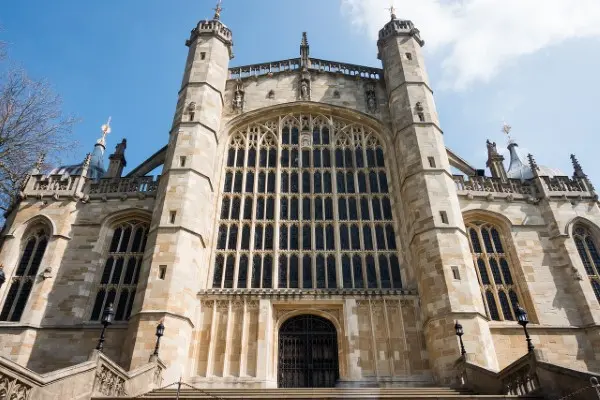
St. George's Chapel
St. George's Chapel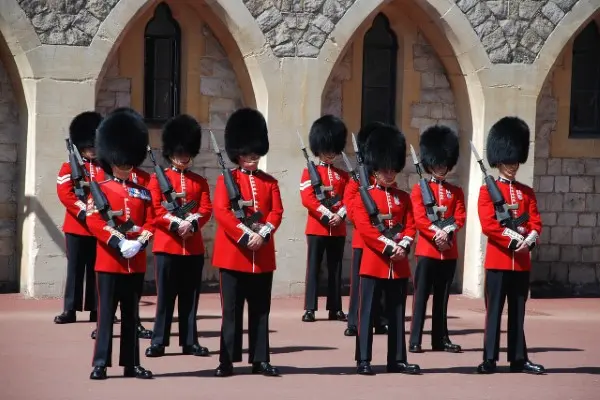
Changing of the Guard
Changing of the Guard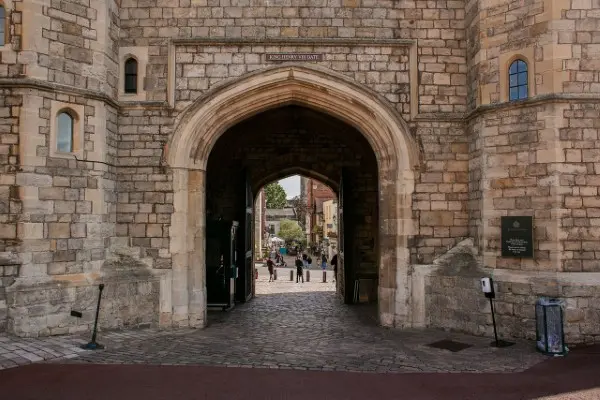
The Staterooms
The StateroomsPrincess Frederica - 1880
Our next bride of the series is the elder daughter of King George V of Hanover. Princess Frederica Sophie Marie Henrietta Amelia Theresa or ‘Lily’ as her family and friends knew her. On the 24th April 1880, she married Baron Alfons Von Pawel-Rammingen at St George’s Chapel.
Courted by several notable suiters, including Alexander, Prince of Orange and Prince Leopold the Duke of Albany, Lily was in love with her father’s former equerry. And so, following on from Alfons becoming a British subject and gaining Queen Victoria’s blessing, the pair were married.
In the following March at 33, Lily became a mother to Victoria Georgina Beatrice Maud Anne von Pawel-Rammingen, tragically the baby died 20 days later.
Tennyson wrote a quatrain in honour of the marriage and in tribute to the bride’s blind father who passed away two years earlier.
" O you that were eyes and light to the King till he passed away
From the darkness of life —
He saw not his daughter — he blest her: the blind King sees you to-day,
He blesses the wife"
Queen Victoria played a large role in the marriage which was not well thought of in certain circles. The Queen wrote: “Every inch a Queen she looked; her dress was my gift made at Paris with the Irish lace trimming and the veil the same. I led her in and gave her away. Her own mother refusing to give her, her blessing and her sister and brother casting her off. She looks on me as her mother, and on Beatrice and Leopold as her sister and brother."
Queen Victoria also wrote to the Crown Princess of Prussia: As we approached the Chapel, I took Lily’s hand, & led her up to the Altar, the organ playing Gounod’s Marche Religieuse. Lily spoke very distinctly, though the numbers of names both have, were rather troublesome for them & the Bishop. I gave Lily away. It was a very pretty wedding. When the service was concluded, dear Lily turned & kissed me with the greatest affection."
Frederica was involved with many charitable organisations, including work with the blind and deaf. Eventually, she and Alfons gave up their apartment at Hampton Court to spend their time in their Villa Mouriscot, in Biarritz, France. Princess Frederica passed away in 1926 in her beloved Baarritz, she was buried in St George’s Chapel in the Royal Vault at Windsor Castle.
Princess Helena Frederica Augusta- 1882
Prince Leopold, eighth child of Queen Victoria, suffered from haemophilia and epilepsy which was an illness that many of the families at that time kept hidden as epilepsy was considered a social stigma. Leopold found himself rejected by several potential brides and so Queen Victoria and daughter Victoria decided to take on the matchmaking role.
Helena Frederica Augusta, Her Serene Highness Princess Helena of Waldeck-Pyrmont was born to parents George Victor, Sovereign Prince of Waldeck-Pyrmont and Princess Helena of Nassau on the 17th February 1861. The fifth child of seven, she was raised at Arolsen Castle in the capital of the Principality of Waldeck-Pyrmont now known as Bad Arolsen, located in Hesse, Germany. She benefitted from a Lutheran education provided by a liberal minded tutor which encouraged her to be well educated and academic.
Helena and Leopold first met in 1881 in Darmstadt and by November the couple were engaged. Leopold was ecstatic. Writing to his brother in law Louis he said, “when you really know her, then you will understand why I’m mad with joy today.” The wedding took place on 27th April 1882.The bride was given away by her father. Music was written for the day by Leopold’s friend, French composer Charles Gounod.
Her dress was a gift from her sister Queen Emma of the Netherlands. It was crafted from white satin and decorated with traditional orange blossom and myrtle. They had two children, Alice and Charles Edward.
Tragically after only two happy years together, Leopold slipped and fell suffering a head injury which, combined with his haemophilia, resulted in an early death aged only 31. He never knew his son who was born four months after the accident.
Helena died following a heart attack, she was 61 years old. She chose to be buried in the stunning Austrian countryside of Hinteriss, after spending her life at Claremont house. She will be remembered for her work with the community of Deptford and the Albany Institute.

Queen Mary's Dolls House
Queen Mary's Dolls House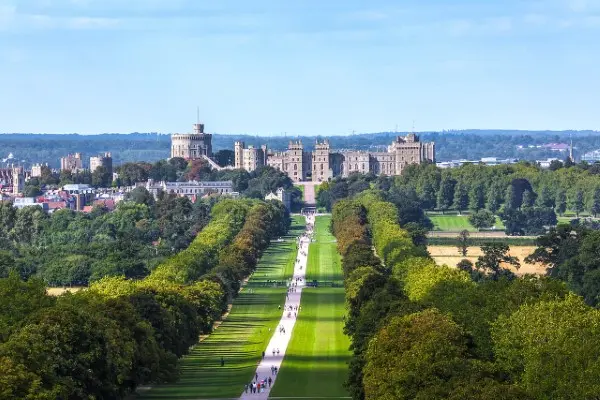
Windsor Castle Fire - 1992
Windsor Castle Fire - 1992
The Order of the Garter
The Order of the GarterPrincess Marie Louise- 1891
Princess Marie Louise of Schleswig-Holstein and Prince Aribert of Anhalt were married on the 6th July 1891 following a very swift courtship. Aribert’s proposal was accepted after only four weeks and they were married within 8 months.
Her father was Prince Christian of Schleswig-Holstein and her mother Princess Helena, fifth child and third daughter of Queen Victoria. It was to the Queen that Princess Helena turned, in panic, when eight years into the marriage, the Duke of Anhalt demanded his daughter-in-law, Marie Louise face divorce proceedings on the grounds, she had made life intolerable by neglecting her marital duties. Divorce at the time being taboo.
Although never directly suggested, rumours circulated that Aribert was caught being indiscrete with a male attendant. This would explain the Prince being cold and indifferent following the wedding, preferring the company of male officers to that of his wife.
Marie Louise was often lonely for weeks at a time, heavily restricted in the German Duchy by rules and protocols governing every part of her life. A far contrast from her loving, outdoor play in childhood and extremely close bond with Queen Victoria. She later shared she wasn’t wanted by her husband who found her presence to be irksome.
Queen Victoria, notoriously well informed, refused to send Marie to Dessau and brought her grand daughter home to England. Horrified to learn of the untrue allegations made against her she sought help from the Queen who had the marriage quietly annulled on the grounds it was never consummated. Despite the sad sorry situation, Marie believed she had made a solemn promise and never remarried wearing her wedding band for the rest of her life.
She wrote an autobiography which touched many called ‘My memories of six reigns’ and within a few months died at her Berkeley Square home. She was interred with her parents at Frogmore Royal Burial Ground.
